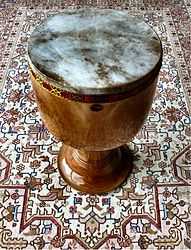Dastgah
| Persian arts |
|---|
 |
| Visual arts |
| Decorative arts |
|
| Literature |
| Performance arts |
| Other |
Dastgāh (Persian: دستگاه) is a musical modal system in traditional Persian art music. Persian art music consists of twelve principal musical modal systems or dastgāhs; in spite of 50 or more extant dastgāhs, theorists generally refer to a set of twelve principal ones. A dastgāh is a melody type on the basis of which a performer produces extemporised pieces.
Each dastgāh consists of seven basic notes, plus several variable notes used for ornamentation and modulation. Each dastgāh is a certain modal variety subject to a course of development (sayr) that is determined by the pre-established order of sequences, and revolves around 365 central nuclear melodies known as gushehs (each of these melodies being a gusheh) which the individual musician comes to know through experience and absorption. This process of centonization is personal, and it is a tradition of great subtlety and depth. The full collection of gushehs in all dastgāhs is referred to as the radif. During the meeting of The Inter-governmental Committee for the Safeguarding of the Intangible Heritage of the United Nations, held between 28 September – 2 October 2009 in Abu Dhabi, radifs were officially registered on the UNESCO List of the Intangible Cultural Heritage of Humanity.[1][2][3][4]
The dastgāh system has been a major influence in the maqam system in the Arabic music, both of which are deeply rooted in the Sassanid Persia's melodies which entered into the Islamic world following the Arab conquest of Iran in the 7th century.
The system of twelve dastgāhs and gushehs has remained nearly the same as it was codified by the music masters of the nineteenth century, in particular Mîrzā Abdollāh Farāhāni (1843–1918). No new dastgāh or large gusheh has been devised since that codification. When in the modern times an āvāz or dastgāh has been developed, it has almost always been through borrowings from the extant dastgāhs and gushehs, rather than through unqualified invention. From this remarkable stability one may infer that the system must have achieved "canonical" status in Iran.[citation needed]
The terminology of Dastgāh
The term dastgāh has often been compared to the musical mode in Western musicology. This however does not reflect the correct meaning of the term. The term can be described by noting that a dastgāh is usually the name of the initial mode of a piece of music being played which is referred to again and again and moreover a dastgāh identifies a group of modes which are grouped together according to tradition. In short, a dastgāh is both the collective title of a grouping of modes as well as the initial mode of each group.[5]
According to musicians themselves, the etymology of the term dastgāh is associated with “the position (gāh) of the hand (dast) [on the neck of the instrument],” The Persian term dastgah can be translated as "system," and dastgāh is then "first and foremost a collection of discrete and heterogeneous elements organized into a hierarchy that is entirely coherent though nevertheless flexible."[6]
In conventional classifications of Persian music, Abu-ata, Dashti, Afshari, and Bayat-e-tork are considered to be sub-classes of Shur dastgāh. Likewise, Bayat-e-esfahan is defined as a sub-class of Homayoon, reducing the number of principal Dastgahs to a total of seven. The sub-classes in the conventional system are referred to as "Avaz".
The Seven Dastgahs
The following is a list of the 7 dastgāhs and 7 Aavaaz:
- Se'gāh ("third place")
- Chahār'gāh ("fourth place")
- Rāst-Panj'gāh ("fifth place")
- Šur
- Bayāt-e Tork
- Abu'atā
- Dashti
- Afshāri
- "Kordi Bayat"
- Māhur
- Homāyoun
- Esfahān
- " Shoshtari"
- Navā
—Note that in some cases the sub-classes (āvāz) are counted as individual Dastgāh, yet this contradicts technicalities in Iranian Music.
Notes
- ↑ The Radif of Iranian music: Inscribed in 2009 on the Representative List of the Intangible Cultural Heritage of Humanity, UNESCO.
- ↑ Noruz and Iranian radifs registered on UNESCO list, Tehran Times, 1 October 2009, .
- ↑ Persian music, Nowruz make it into UN heritage list, Press TV, 1 October 2009, .
- ↑ Nowruz became international, in Persian, BBC Persian, Wednesday, 30 September 2009, .
- ↑ (Farhat 2004) p.19.
- ↑ (During 1996)
See also
References
- Farhat, Hormoz (2004). The Dastgah Concept in Persian Music. Cambridge University Press. ISBN 0-521-54206-5.
- During, Jean. "Dastgāh". Encyclopaedia Iranica.
Further reading
- Hormoz Farhat, The Dastgāh Concept in Persian Music (Cambridge University Press, 1990). ISBN 0-521-30542-X, ISBN 0-521-54206-5 (first paperback edition, 2004). For a review of this book see: Stephen Blum, Ethnomusicology, Vol. 36, No. 3, Special Issue: Music and the Public Interest, pp. 422–425 (1992): JSTOR.
- Ella Zonis, Classical Persian Music: An Introduction (Harvard University Press, 1973)
- Lloyd Clifton Miller. 1995. Persian Music: A Study of Form and Content of Persian Avaz, Dastgah & Radif Dissertation. University of Utah.
- Bruno Nettl, The Radif od Persian Music: Studies of Structure and Cultural Context (Elephant & Cat, Champaign, 1987)
- Ella Zonis, Contemporary Art Music in Persia, The Musical Quarterly, Vol. 51, No. 4, pp. 636–648 (1965). JSTOR
- DURING, JEAN. "DASTGĀH". Encyclopædia Iranica. Retrieved 2012-08-21.
External links
- The Dastgah system
- A sample of solo music on Setār by Master Ahmad Ebadi in the following Dastgahs: Segāh, Chahārgāh, Homāyoun, Esfahān, Afshāri.
| ||||||||
| ||||||||||||||||||||||||
